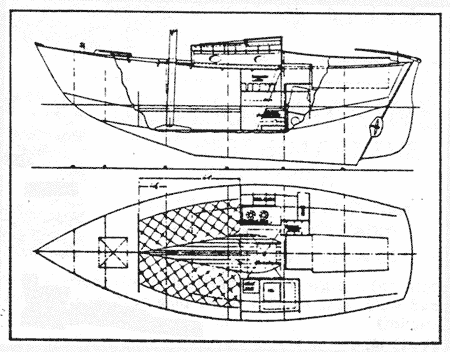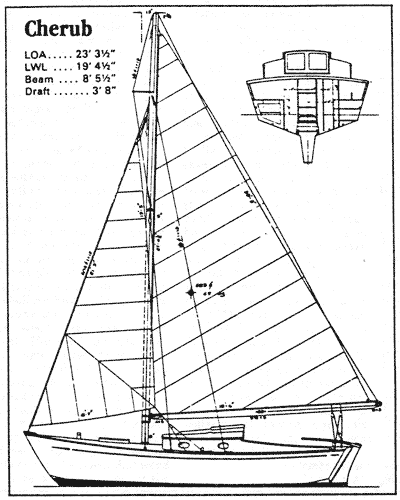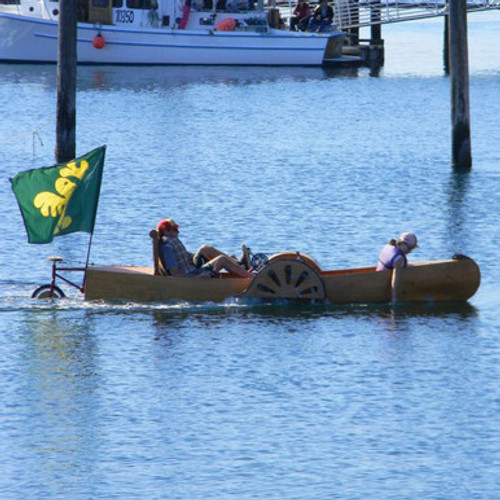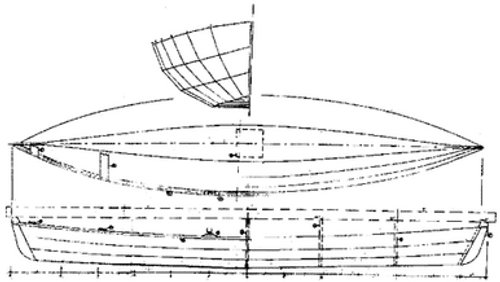"CHERUB" - 23' Sailboat, steel. Redesign of Sam Rabl's popular little sloop "PICAROON". Sloop rigged for easy handling. 23' 3" LOA, 19' 4" LWL, Beam 8' 5". Draft 3' 8". Plans include 4 sheets. Displacement 5,000 Ibs. Includes construction and arrangement drawings, lines, table of offsets, sail plan, outboard and inboard profiles, etc.
Cherub is Weston Farmer’s 23 foot update, in steel, of Sam Rabl's classic tabloid cruiser Picaroon. During the early twenties, Rabl designed a hard-cbme I8-foot cruising sloop for his own use. After sailing her on the Chesapeake in all kinds of weather, he declared, ‘She’s the slickest handling little piece of wood I ever got my hands on.’ That was the first Picaroon, a boat that could be built in those days for about $1000. The design won worldwide fame for Rabl, following the publication of her plans in the June 25, 1925 issue of Motor Boating. No wonder, she proved to be a remarkably able little craft. Ernest Hemingway’s brother, Hank, built one in Mobile, Alabama and sailed her safely to Cuba through a storm that blew him almost to the Yucatan Peninsula. Other Picaroon sailors have told similar tales.
Sam Rabl's fellow naval architect and friend Westy Farmer was among Picaroon’s enthtusiastic admirers. He called the little ship “a delight to the eye of every sailorman. Farmer, who wenthered the Depression by editing magazines for Fawcett Publications, featured a raised-deck version of Picaroon, called Buddy, in the October, 1932 issue of his Mechanical Package Magazine. Almost half a century later, Buddy resurfaced when Mark Miller, a West Coast nautical journalist, submitted an article to Small Boat Journal about “a jaunty little tabloid cruiser” he had spotted lying to a float in Santa Barbara. Her rame was Picaroon, which created some confusion as to her true identity. SBJ sent Miller’s manuscript and pictures to Westy Farmer who immediately identified that Picaroon” as a Buddy, and added this explanation:
Sam Rabl undoubtedly loved all the boats he designed for the home craftsman to build in his backyard, barn, garage, or where ever there was some free space, but perhaps his Picaroon’s hull was something special. Sam designed a sequel named Peggy, which had too deep a vee to the bottom. His next was Buddy — all Picaroon hull and deadrise but with the Dutch-type raised deck of this Santa Barbara boat A multi- chine plywood design came later, but that boat, Picaroon II, was not a great success because she was almost round bottomed and too tender. A few years before Sam’s death in 1962, he designed Picaroon III — larger, but with the Picaroon deadrise. Sam liked the Picaroon hull.

Seeing Millers picture of a restored Buddy fired Farmer’s imagination. Only a few years later, in 1976, he had scored a phenomenal success by redesigning John Hanna's famed Tahiti ketch in steel, as Tahitiana. Perhaps the same could be done with Rabl’s little gem, offering a safe, comfortable and good-lookjng little cruiser within the reach of those who could not afford or did not want, a vessel as large as the 31-foot 6-inch Tahitiana.
The way to go now would be in steel," Farmer wrote in notes that his son Mike provided. A steel boat could be built in half the time at a third the cost of any other method. The steel market is depressed; arc welding is a substitute for the fastenings; and today, arc-welded steel is within the technical reach of skills not known in Rabl's day. Welding is known to thousands of mechanics in repair shops everywhere and is readily learned.
"The itch to spring a steel Buddy on the boating world has gripped me,” he continued. "Can I get Buddy out of steel, or will I have to add volume, and hence size, to maintain the waterline and trim?"
As the design work progressed, he wrote:"I have engineered the idea to fit the weight requirements of building in arc-welded steel, sweetening up the lines a bit and enlarging the hull to give a water plane that would carry the steels added weight. In short, Cherub is a brand new design with the deficiencies of the old wooden hulls eliminated.”
The Cherub that finally emerged was not a raised-deck vessel like Buddy, but has a trunk cabin similar to that of the original and subsequent Picaroons. Her size and general configuration closely recall Picaroon III. Cherub measures 23 feet 3½ inches overall, 19 feet 4-3/4 inches on the water, and 8 feet 5-½ inches across her beam. She draws 3 feet 8 inches. Picaroon Ill measures 23 feet, 18½ feet, 8 feet, and 4 feet.
By the time Mark Miller’s article, "The Picaroon Is an Eye-Catcher,” appeared in SBJ #13, August, 1980, a prototype of the reworked Buddy, or should I say Picaroon, was already under construction in Florida. Farmer contributed a short sidebar to Miller’s article. In it, he said, "I have hopes of a trial within a few months to check out how Sam Rabl's enlarged dream, fitted with a new halo, will hook the man who wants to build his own escape machine, Cherub is on the ways."

Although he already had suffered the first of a series of heart attacks that soon took his life, Westy Farmer flew to Flonda as soon as the Cherub prototype was launched. She sailed beautifully, he reported, ghosted nicely, responded quickly to the helm, went well to windward, and in all respects performed like the sweet little cherub she is named for. But a problem in the initial construction had given the prototype a look above the waterline that was not what Farmer intended; so, he abandoned the prototype.
Westy Farmer's health deteriorated rapidly after the Florida trip, and though he continued to talk enthusiastically about the Cherub project, even from his hospital bed, he never returned to his drawing board. He died on May 14, 1981, and Cherub remained an unfulfilled legacy.
Enter Nelson Zimmer. He was the only other naval architect to whom Weston Farmer would entrust any of his drafting work, and he volunteered to complete Cherub’s plans for Westy’s widow.
Nelson Zimmer writes: "Cherub is a chine configuration with a hollow-plate keel arranged to accept some form of ballast cast therein — lead, concrete with scrap metal, or whatever. Because the actual amount of ballast depends on what the rest of the ship weighs — and this is sure to vary among amateur builders — I have instructions in the bill of materials to ballast the complete vessel to her designed waterline.
"It is intended that the boat be built without transverse frames. The hull should be plated bottom up over temporary rough molds of wood or steel in which notches should be provided to accept the indicated longitudinal stringers. After the plating is fully welded, the shell should be righted and the stringers pressed out to lay on the shell for final welding. Deck and trunk may be either steel or wood; wood gives less topside weight. The little Universal inboard engine shown on the drawings is preferable, I think, to an outboard, which has to be manhandled and stowed someplace if it isn’t to be hung permanently on the transom. Westy’s preliminary sketches showed a wooden mast and boom. Although aluminum could be used. I suspect that wood might be a little cheaper if the builder doesn't count his labor."
Cherub is no thousand-dollar yacht — remember that when Rabl built his first thousand-dollar Picaroon, a person could still buy a five-cent cigar — nor is she outrageously expensive to build, She is, instead, a lot of good boat for today’s dollar.
James Brown







